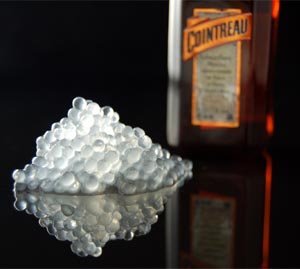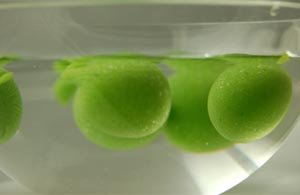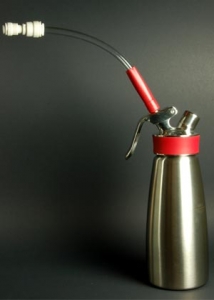Molecular gastronomy or molecular cuisine is the science of cooking but it is commonly used to describe a new style of cuisine in which chefs explore new culinary possibilities in the kitchen by embracing sensory and food science, borrowing tools from the science lab and ingredients from the food industry and concocting surprise after surprise for their diners. Formally, the term molecular gastronomy refers to the scientific discipline that studies the physical and chemical processes that occur while cooking. Molecular gastronomy seeks to investigate and explain the chemical reasons behind the transformation of ingredients, as well as the social, artistic and technical components of culinary and gastronomic phenomena in general. The term Molecular Gastronomy was born in 1992 (complete history on this post: Molecular Gastronomy History).
Many of these modern chefs do not accept the term molecular
 gastronomy to describe their style of cooking and prefer other terms like "modern cuisine", "modernist cuisine", "experimental cuisine" or "avant-garde cuisine". Heston Blumenthal says molecular gastronomy makes cuisine sound elitist and inaccessible, as though you need a BSc to enjoy it. In the end, molecular gastronomy or molecular cuisine - or whatever you want to call this cooking style - refers to experimental restaurant cooking driven by the desire of modern cooks to explore the world's wide variety of ingredients, tools and techniques. Molecular gastronomy science research starts in the kitchen and the learnings of how food tastes and behaves enable these chefs to cook with it and discover new sensory pleasures with it.
gastronomy to describe their style of cooking and prefer other terms like "modern cuisine", "modernist cuisine", "experimental cuisine" or "avant-garde cuisine". Heston Blumenthal says molecular gastronomy makes cuisine sound elitist and inaccessible, as though you need a BSc to enjoy it. In the end, molecular gastronomy or molecular cuisine - or whatever you want to call this cooking style - refers to experimental restaurant cooking driven by the desire of modern cooks to explore the world's wide variety of ingredients, tools and techniques. Molecular gastronomy science research starts in the kitchen and the learnings of how food tastes and behaves enable these chefs to cook with it and discover new sensory pleasures with it.Molecular gastronomy experiments have resulted in new innovative dishes like hot gelatins, airs, faux caviar, spherical ravioli, crab ice cream and olive oil spiral. Ferran Adria from El Bulli restaurant used alginates to create his system of spherification which gelled spheres that literally burst in your mouth. Heston Blumenthal from The Fat Duck restaurant applied the learnings of the ability of fat to hold flavour to create a dish that had three flavours -basil, olive and onion - and each of them was perceived in turn. The potential of molecular gastronomy is enormous. It is revolutionizing traditional cooking and transforming eating into a whole new emotional and sensory experience.
 When people hear molecular gastronomy or molecular cuisine for the first time they often mistakenly view it as unhealthy, synthetic, chemical, dehumanizing and unnatural. This is not surprising given that molecular gastronomy often relies on fuming flasks of liquid nitrogen, led-blinking water baths, syringes, tabletop distilleries, PH meters and shelves of food chemicals with names like carrageenan, maltodextrin and xanthan. My wife's first reaction when I surprised her with aliquid pea spherical raviolo was to say "Can I eat this? Is this safe? Why don't you try it first?".
When people hear molecular gastronomy or molecular cuisine for the first time they often mistakenly view it as unhealthy, synthetic, chemical, dehumanizing and unnatural. This is not surprising given that molecular gastronomy often relies on fuming flasks of liquid nitrogen, led-blinking water baths, syringes, tabletop distilleries, PH meters and shelves of food chemicals with names like carrageenan, maltodextrin and xanthan. My wife's first reaction when I surprised her with aliquid pea spherical raviolo was to say "Can I eat this? Is this safe? Why don't you try it first?".The truth is that the "chemicals" used in molecular gastronomy are all of biological origin. Even though they have been purified and some of them processed, the raw material origin is usually marine, plant, animal or microbial. These additives are also used in very, very small amounts and have been approved by EU standards. And the science lab equipment used just helps modern gastronomy cooks to do simple things like maintaining the temperature of the cooking water constant (water bath) , cooling food at extremely low temperatures fast (liquid nitrogen) or extract flavour from food (evaporator). There is still some debate out there about the healthiness of molecular gastronomy but I personally believe there are other bigger health issues in everyday food we consume. In the end, you are not going to be eating liquid pea spheres every day anyway.
 If you are passionate about cooking, have a creative mind and at the same time you are analytical and logical, molecular gastronomy is most likely going to become your passion. Molecular gastronomy cooking requires a good use of your left brain and right brain. Most of the molecular cuisine recipes need to be followed precisely. More than often, steps need to be followed in a very specific sequence or the whole dish will be a disaster. Quantities are measured in fractions of a gram or fractions of a percentage. Slight variations in food acidity levels could be disastrous for some dishes like a learned when making caviar for the first time as I replaced melon with pomegranate. At the same time, molecular gastronomy is about experimenting, being curious, using intuition, playing with emotions and creating a multi-sensory dinning experience with artistic dish presentations, textures, aromas, flavours and even sounds. The plate is your canvas! Or do you need a plate? How about serving soup in a tea cup or a sphere in a bended spoon or a salad in a parmesan basket or a bruschetta on a titanium mesh? Ok, maybe the titanium mesh is too much. Let's leave this for the expensive molecular gastronomy restaurants.
If you are passionate about cooking, have a creative mind and at the same time you are analytical and logical, molecular gastronomy is most likely going to become your passion. Molecular gastronomy cooking requires a good use of your left brain and right brain. Most of the molecular cuisine recipes need to be followed precisely. More than often, steps need to be followed in a very specific sequence or the whole dish will be a disaster. Quantities are measured in fractions of a gram or fractions of a percentage. Slight variations in food acidity levels could be disastrous for some dishes like a learned when making caviar for the first time as I replaced melon with pomegranate. At the same time, molecular gastronomy is about experimenting, being curious, using intuition, playing with emotions and creating a multi-sensory dinning experience with artistic dish presentations, textures, aromas, flavours and even sounds. The plate is your canvas! Or do you need a plate? How about serving soup in a tea cup or a sphere in a bended spoon or a salad in a parmesan basket or a bruschetta on a titanium mesh? Ok, maybe the titanium mesh is too much. Let's leave this for the expensive molecular gastronomy restaurants.If you are not a professional chef with a fully equipped kitchen you can still enjoy molecular gastronomy at home and without spending too much money. Many molecular cuisine recipes don't even require especial equipment or "chemicals". Even with as little as $50 you can get some basic molecular gastronomy substances to start making spheres, airs and gels. Of course, cooking with liquid nitrogen is a different story even though it is totally doable at home but you'll have to spend about $500 and carefully follow some safety procedures not to injure yourself or your loved ones.
That's why I created this molecular gastronomy website with recipes that I or my readers have tried at home and modified as necessary, tips and techniques to get the best results with molecular recipes and successfully create your own signature dishes, affordable ways of acquiring or substituing molecular gastronomy equipment and substances and beautiful pictures of finished dishes to inspire your creativity. I welcome professional chefs, amateur cooks and scientists to use this molecular gastronomy website to collaborate in building this community to make molecular gastronomy more accessible and affordable to everyone. People should not be deprived of the multi sensory pleasures of molecular gastronomy.The major challenge is going to be finding good molecular cuisine recipes with complete detailed explanations, learning the basic principles behind each recipe so you can be creative and come up with your own dishes and finding good pictures of finished dishes so you know how they are supposed to look. It seems like molecular gastronomy chefs don't want to share their secrets completely and they just give you a truncated version of the recipe.



Posting Komentar